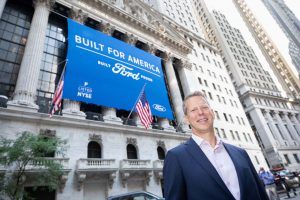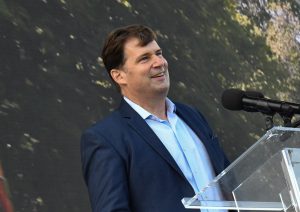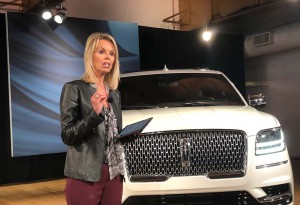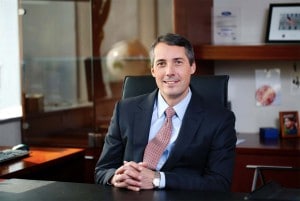
Jim Farley isn’t wasting time in his new role as Ford Motor Co. chief executive officer, within hours of taking the reins announcing a management shakeup and plans to speed up the automaker’s turnaround program.
Among the most notable of the new “leadership changes” announced by the number two U.S. automaker, Ford Chief Financial Officer Tim Stone is heading to a senior position at ASAPP Inc., an artificial intelligence software company. Stone, a relatively new hire with no previous automotive experience, will be replaced by company veteran John Lawler. Thursday’s announcement shows the reshuffling isn’t complete, with several key jobs, including the roles of chief information and chief marketing officers, left open for now.
As Farley settles into his new office he made it clear he plans to speed up the transformations launched by his predecessor, Jim Hackett, who was repeatedly faulted for taking too long to deal with many of the challenges facing the automaker.
(Shakeup at Ford: Hackett out, Farley in as CEO.)

“During the past three years, under Jim Hackett’s leadership, we have made meaningful progress and opened the door to becoming a vibrant, profitably growing company,” Farley said. “Now it’s time to charge through that door.”
Profitable? Not necessarily. Ford did significantly outperform Wall Street’s estimate for the second quarter this year, however, with an adjusted pre-tax loss of $1.9 billion compared to an anticipated deficit closer to $5 billion.
But that’s not necessarily what has worried investors who have seen Ford shares stuck in the doldrums for several years. The stock hit a 52-week low of $3.96, though it currently is back up just below $7. It hasn’t seen the up side of $10 since July 2019.
What analysts have frequently complained about, especially during the tenure of Hackett, was a lack of clarity and a questionable sense of urgency. It hasn’t helped that Ford has gone through a series of management overhauls since Alan Mulally retired in 2014. His hand-picked successor, Mark Fields, was ousted three years later and replaced by board member Hackett. The former Steelcase CEO said this summer he would retire, though he was clearly under pressure to step aside.
Since Mulally left, all three of his successors have laid out reasonably similar strategies aimed

at transforming Ford from an automotive manufacturer into a broader, high tech-focused mobility company. But the details of how it plans to get there – and how quickly – have raised plenty of questions.
From a broad perspective, new CEO Farley said he didn’t foresee major changes in direction when he was named to the post. But he clearly needs to be both more aggressive and more transparent, according to analysts like Joe Phillippi, head of AutoTrends Consulting.
Ironically, a number of the steps undertaken by Hackett are set to soon bear fruit, starting with this year’s launch of Ford’s first long-range battery-electric vehicle, the Mustang Mach-E.
(Ford names Farley COO; President, Automotive Hinrichs retires.)
In its Thursday statement, Ford said that the changes Farley is launching are meant to “turn around automotive operations; allocate capital to Ford’s strongest franchises and high-growth opportunities; and produce compelling, uniquely Ford electric vehicles at scale.”
To get things in motion, Farley is moving fast to pick his own team. The departure of Stone – who will leave the CFO post on Oct. 15 – comes as no surprise to Ford insiders who questioned his hiring in the first

place, having no automotive experience. He previously worked at Amazon and was instrumental in the online retail giant’s acquisition of Whole Foods.
His replacement, 54-year-old Lawler, is currently serving as CEO of Ford Autonomous Vehicles. He’s held a variety of titles during his tenure at the automaker, including spending significant time in Ford’s finance operations. He also had a stint as president of Ford China. All those CV bullet points are expected to be useful to Farley, who is a big proponent of driverless technology and needs to get Ford’s struggling Chinese operations back on track.
“John knows our company inside-out, has a clear view and great ambition for what Ford can be, and articulates what’s needed to get there,” Farley said in Ford’s statement. “As CFO, he will help assure we have the means to fund those ambitions.”
The 11th Ford CEO since it was founded 117 years ago, Farley’s reorg will be felt in a number of areas. Among other personnel leaving the company, Jeff Lemmer will retire Jan. 1 as Ford’s chief information officer, while Dale Wishnousky will retire at the end of this year as head of European manufacturing. Meanwhile, Joy Falotico, who has been doing double duty as both president of Lincoln and Ford’s chief marketing officer, will relinquish her latter role in order to focus on the luxury brand’s nascent turnaround.

Notably, Farley has yet to name replacements for the CIO and CMO posts. It’s unclear if he will turn to talent in-house or try to recruit from the outside.
The 58-year-old Farley will be under intense pressure to deliver clear results. It will help him to have the U.S. automotive market recovering faster than expected from the coronavirus pandemic — which forced Ford, like the rest of the U.S. industry, to shut down manufacturing operations for much of the second quarter.
(New Ford CEO Hackett draws comparisons to former chief Mulally.)
Farley also will benefit from the launch of not only the Mach-E battery-car but three other key models in the months ahead: the next-generation F-150, and two new SUVs, the Bronco and the Bronco Sport. The company claims to have significant advance orders for all four new vehicles.







